I lost $ 75.48 on a Facebook ad campaign, and you can too! -OR- Can Facebook ads sell books? Quick answer: no. Long answer: noooooooooooooooo.
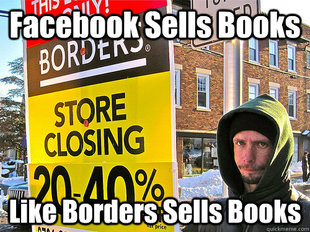

(part of my ongoing Search Engine Optimization for Authors series[1]I understand that paid search ads aren’t traditionally umbrellaed under search engine optimization. However, because tracking and optimization is involved, I’m including it in the series)
Part of being a great author-marketer is knowing how to filter promotion time wastes from time worthwhiles. Some options are simple to filter. “Should I do a Goodreads.com giveaway to attract potential readers?” Yes (all it costs is the price of a few copies of a book to receive interest from hundreds of readers). “Should I rent a billboard for a month?” No (billboards offer either 1) travel-oriented products/services or 2) products with a high profit margin). Some options aren’t so simple. And in the case of the Facebook ad, prominence adds to the should I or shouldn’t I debate. Well, I’m here to help.
Are Facebook ads a good choice for self-promoting authors to sell books? Simple answer: no.
Scroll down to the bottom of this post is you want the quick n’ filthy results. Otherwise, continue reading for the in-depth analysis.
During the past month, I’ve been testing a Facebook ad campaign for one of my books. I approached the project with the intentions of sharing the results with you lovely readers. So, it was important to me that I document everything—to a nauseating level of detail—to best understand not only the results but the methodology as well. My hope is that I not only provide you with the campaign’s success (or lack thereof, in this case) but also with some possible alterations that may be worth trying should you or I decide to run a second campaign.
My credentials -or- “Why the hell should I listen to you?”
I have over 7 years of search marketing experience working with SEO and Paid Search (Google Ads, Facebook ads, etc.) interactive marketing agencies. I am also an author, so I understand that even though money is important, often a readership is a valid KPI (that’s Key Performance Indicator; see, I know some jargon). This Facebook campaign, however, will be focused on sales and profit.
Campaign structure -or- “You didn’t show a naked woman in the ad just to trick a user to click, did you?”
First, what is a paid search (Facebook or Google AdWords) ad? Basically, the idea is that an advertiser gets charged per click. If a user doesn’t click an ad, then then the advertiser doesn’t pay for the impression. Sounds good, right? Yes, and that’s one of the reasons it is such a lucrative model for the ad publishers and for many businesses who use the ads.
A note about timing: though I have two books coming out at the end of this year, I did not want to skew the results of this Facebook campaign with other promotional efforts. Therefore, I did not mention the titles of the new books in the campaign. Some could argue that this sort of additional branding may have helped the Facebook campaign. I can’t argue with that. However, for the sake of making this test as sterile as possible, I wanted to the ad to stand on its own as much as possible.
Here is how I set up my ad:
- I established four versions of the ad (shown below), changing things like the ad image, title, and copy. However, each ad spoke to the same product offering. This is called A/B testing, which is a way to help identify successful ad variations. Basically, if you were wondering, does the ad title “Dark Literary Fiction” get more clicks than “Like Your Fiction Dark?” A/B testing would be the way to determine this. Ideally, with A/B testing, only a single element would vary between two ad variations. In my case, I was not as interested in these minute changes.
- Each ad version pointed to the same landing page on my website. Because I decided to do the A/B testing at the ad copy level, I didn’t want to confuse the results by also altering the landing page copy. However, testing the landing page is a perfectly valid option in general (and in encouraged for most ad campaigns). Here is the landing page (with a few tweaks, as mentioned below). Though I’m not using the page for the Facebook campaign any longer, the deal is still valid if anyone wants in on it.
- This landing page was unique to the Facebook campaign. For tracking purposes, I don’t want to skew results by having multiple campaigns lead to a single page.
- This landing page included a nofollow, noindex tag, which means it will not be crawled or indexed by search engines. I did not want a user finding this landing page via a search engine. If I were not testing this ad, then I would be okay with having this page indexed. However, because I am testing a specific ad I wanted to keep all other sources of traffic far, far away.
- My own computer IP address is filtered out in my analytics program (Google Analytics, for me). This is something that anyone using an analytics program should do, whether testing an ad or just curiously interested in site traffic. Basically, it is important to not count your own visits to your site when determining the popularity of your site.
- The ad used a Cost per Click (CPC) model (vs. a Cost per Impression (CPM or CPI) model, which charges by impression. The reason for selecting the CPC model is that I wanted to equate specific clicks with specific actions and costs.
The ad demographic targets are as follows:
- These ads targeted about 436,800 users:
- who live in the United States
- between the ages of 18 and 45 inclusive
- who like Choke (novel), Chuck Palahniuk, Craig Clevenger, Fight Club (novel), Invisible Monsters, Lullaby (novel) or noir
- I set an initial CPC bid amount of $0.60 which I varied +/- about $0.30 as ad competition warranted. The initial CPC bid amount was determined based on a Facebook recommendation.
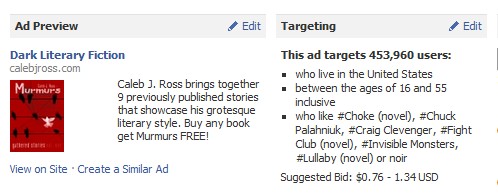
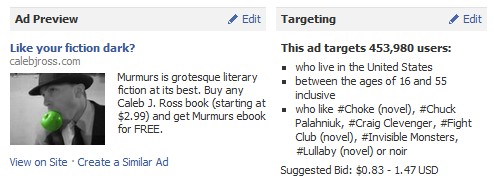
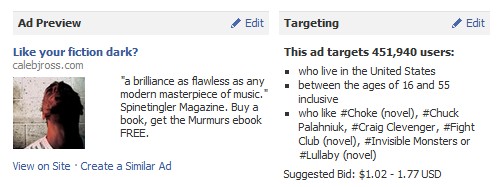
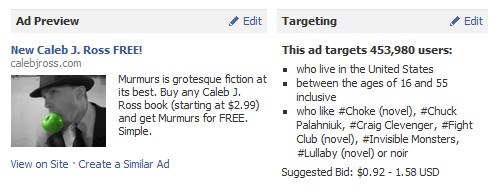
Ad Duration and Budget Terms -or- “SHOW ME THE PARAMETERS!!!!”
- Campaign dates: 11/16 to 12/13 (28 days)
- Initial budget: $10/day. On 11/24 the budget was reduced to $5/day. After 10 days I was already seeing that clicks were not converting into sales. Halving the budget allowed me to continue testing the ad, but without totally losing my ass in the process.
Conversion funnel -or- “Exactly what things did you track to determine success or failure?”
Now that the ad parameters have been established, the next step is tracking the effectiveness of the ad. This is done in three steps:
- How many people click on the ad vs. the number of times the ad appears? This is called the Click-thru-Rate or CTR.
- How many people take some sort of action on the landing page after clicking the ad? This can be either clicking to purchase a book or it can be something as simple as just leaving the page without taking an action.
- How many people follow through by acting on the ad offering (in this case, submitting an email for a free eBook)?
1. Click thru Rate
For the purposes of this test, the CTR isn’t that important. I am only paying when a user clicks the ad, so knowing the CTR really only tells me how compelling the ad copy is. It has no real effect on my bottom line. If I were advertising using the CPM or CPI models, CTR would factor more heavily into the final determination of success.
2. Landing page actions
The landing page for the test ad has two purchase buttons (one for Stranger Will and one for Charactered Pieces). Each purchase button has been appended with event tracking tags so that Google Analytics can tell me exactly how many times each button is clicked. Because I can’t tap into Amazon’s Point of Sale system, I will assume every Buy Button click on my website is a conversion. A 100% conversion rate is wishful thinking, true, but my thoughts are that if someone has already made it this far into the funnel, and has clicked to the buy button, then actually buying a book is likely.
Each event action is given a monetary value based on things such as my royalty percentage, affiliate fees, partner takes, etc. So, these values represent the true profit for me, the author, when a book is purchased. For the sake of transparency, the values are listed below.
- Charactered Pieces from Amazon.com: $2.09; from Barnes & Noble: $1.81
- Stranger Will from Amazon.com: $2.50; from Barnes & Noble: $2.50
3. Offer completions
The point of the ad campaign is to provide readers with a free ebook (which is attained by purchasing a copy of one of my books). In order to claim the ebook, readers must email order confirmations directly to me (details can be found toward the bottom of the Murmurs product page). Receiving one of these order confirmations acts as the “Holy Grail” conversion, as it definitively shows a conversion. However, my entire determination of success cannot be based on this alone, as it is likely not all buyers will care to redeem the offer of a free ebook. Therefore, an Offer Completion is like icing on the Landing Page Action cake.
Observations and Adjustments -or- “You didn’t just ‘set it and forget it, did you Ronco?”
No, I didn’t “set it and forget it” you obvious fan of late night informercials. As the test progressed, I did make subtle tweaks based on observations. I will outline those here.
- 11/21 – age, copy, and images changed due to poor performance (without enough data, I can’t make conclusions)
- 11/28 – I found that I have a 74% bounce-rate, but a time-on-page of about 1:49, meaning people are leaving the page without clicking another on my site, but they are at least reading the page (judging by the 1:49 time-on-page). This means one of two things. Either 1) the free ebook deal just isn’t intriguing enough or 2) the layout of the page is not optimized for conversion. Because I can’t really change the deal without altering the basis of the test, I decided to tweak a few items on the landing page:
- I shrank a few images on the page, fearing that perhaps they were too imposing.
- I removed some extraneous text
- I added the important detail that books could be purchased in ebook OR print versions. I thought, perhaps people thought they had to purchase a print book, which would admittedly be weird considering I am giving away an ebook.
- I added “ebook” to the ad verbiage so the user knows they are getting a free ebook (as opposed to a print book).
- I added an email newsletter subscription option on ebook page (I figured I might as well get something out of the ad)
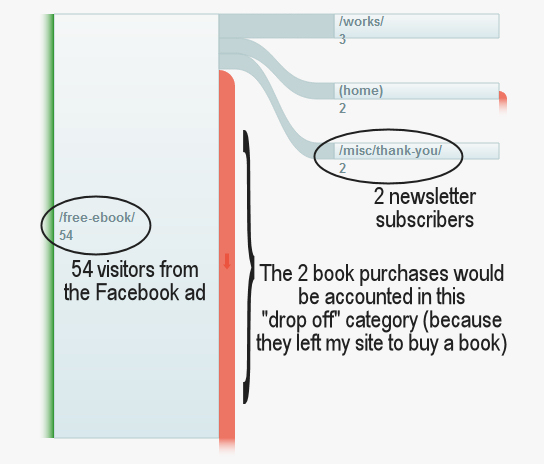
- Total Amount spent: $79.48
- Total Clicks: 152 (strange though that Google Analytics reported only 54 visits; is Facebook over-reporting? Here’s an article from 2009 about one such case. I should look more into this.)
- Total events (clicks from the landing page to buy a book): 2…that’s not a misprint
- Total estimated value: $5
- Is the total estimated value for the campaign larger than the total amount spent? Hells no!
- Average bounce rate: 85.19%
- Average time on page: 1:22
What would I do differently with a second campaign?
- Use a CPM ad instead of a CPC ad. Does the low margin on a book simply make CPC advertising unfeasible? Would a CPM (cost per impressions) model work better? If so, a focus on the book cover itself would be important (rather than shots of people or more “conversion friendly” imagery)?
- Create a more enticing offer. Do people even care about free ebooks? Maybe readers would be willing to buy a full price book if additional freebies were offered. Or, maybe a purchase offer isn’t even necessary. Perhaps a simple “like my page to be entered into a contest for a free print book” would work.
- Promote a different book. Maybe I should write a non-fiction book. I would image those to have better conversions.
- A month long test is overkill. I would not test for a full month. I knew after one week that this campaign was not going to work. I should have used the remaining 3 weeks to test dramatically different versions of the ad or perhaps tested another platform entirely (Google AdWords, for example, though I anticipate the results would not be much different). I will take what I’ve learned and apply to another test at some time in the future, for sure. Be sure to subscribe to this blog RSS feed to ensure that you never miss a post. Another option, subscribe using the button below to get new blog posts sent to you via email.
Other helpful articles about Facebook ads and book selling:
- Do Pay-Per-Click Ads Sell Books? by Laura Pepper Wu
- Do Facebook ads work for authors?
- Facebook Ad sells a Bazillion Books! by Arthur Slade
Footnotes
| ↑1 | I understand that paid search ads aren’t traditionally umbrellaed under search engine optimization. However, because tracking and optimization is involved, I’m including it in the series |
|---|

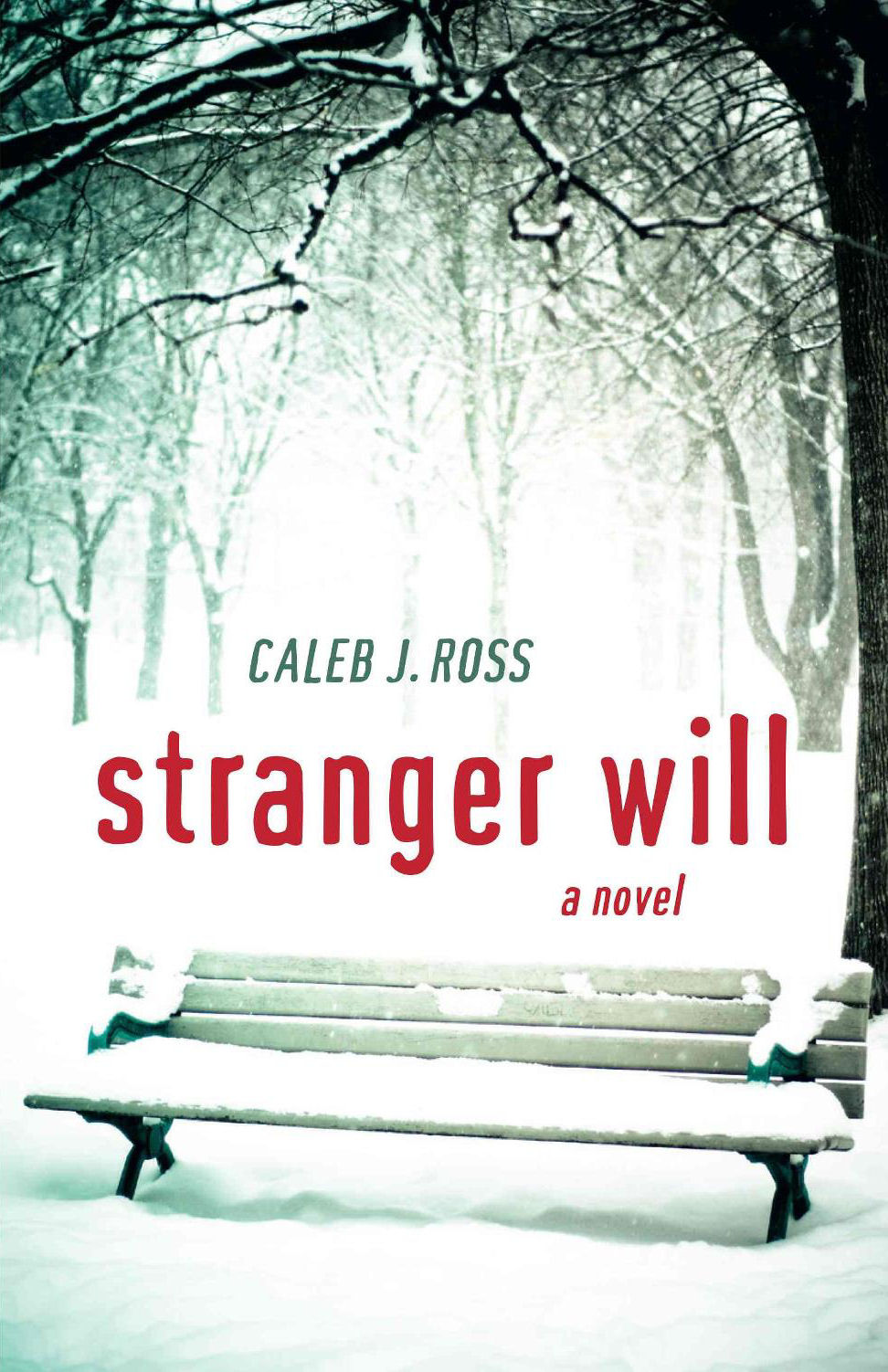
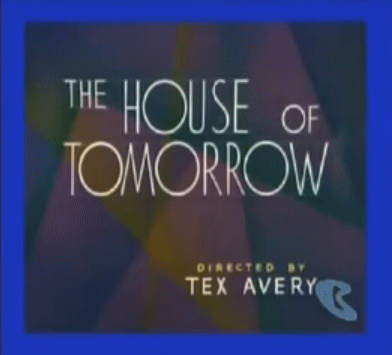
A free ebook is definitely a good deal and would make me more likely to buy. However, I don’t usually click on fb ads. Also, I was not in your demographic. What made you choose to limit your test to only American audiences? Us Canadian-Norwegian readers feel left out here.
Honestly, I have not idea why I didn’t open up the audience. I think I just didn’t realize until I had already been going for a couple of weeks. I’m a dufus. I guess that’s two more things to keep in mind for the next test: 1) bigger geography and 2) broader demographic. Thanks!
Thanks for sharing your work, Caleb. This sort of stuff is always useful. I’ve done a lot of work with Facebook ads for my own books and other projects. A couple things:
1. CTR does matter, since the higher the CTR the lower the CPC (the better the ad the less you pay.) Efficiently nailing your target market without excess pays off.
2. I’m not sure any PPC ad system — including Google Ads (and I’d love to see a similar report on that) — will yield straight revenue ROI for a book. The unit cost is too low. HOWEVER, I think Facebook ads are amazing for audience development, if used with FB’s “Like” functionality.
Basically, if you make your book an FB page or a “node” — an FB object with no FB page — you can accumulate Fans at well less than $1.00 per fan. In this case you might have generated 100 fans, which is almost as good — if not quite — as 100 email subscribers. (You might even handicap FB fans as .25 of email subscribers.)
These are then followers who you might a) convert in the future and b) whose every engagement becomes a free ad for your book, i.e. a new prospect in the funnel for free.
The trick would be putting a lifetime value on a FB fan.
In my experience, it was this lack of audience development — or accumulation — that made AdWords appear unworkable for books, but I’d love to be proven wrong about that.
I think you nailed it on two points: 1) the unit cost or low profit margin, and 2) the idea of nodes, or keeping users within the Facebook interface. I am actually listing to a FB webinar right now and the idea of nodes was just brought up and emphasized. Thanks!
Caleb, I think I have to go with Jim on this in the sense that FB ads might be better served for an author to generate FB likes. Getting qualified people to like you could result in more response down the road. I would also think having the title might be imortant too. Many people really buy based on cover and title to sway them – I’m an advertising sales rep by day, author at night and you can really see how an ad can perform differently based on utilizing different key strategies in an ad. I do believe there may have been a slight, not great, difference in the ad results based on that. Really great article and I will definitely start following you.
Thanks Elyse. I agree with the cover and title method for books, for the most part. I did a (admittedly unscientific) poll a few months asking how people decide to purchase books (https://calebjross.com/marketing/how-do-readers-choose-books-poll-results/). Author and Cover/Title/Synopsis were the top draws. Not surprising, I suppose. I used a lot of people imagery in this particular test, as I’ve read that the CTR is higher for FB ads featuring people. Still, a book cover many have focused my audience a bit more, which would have been needed in this case. Thanks again!
You targeted too broadly and you tried to hard sell. Try just collecting subscribers to a free newsletter, or just give away books for free. I think you’re thinking too hard and missing the big picture.
[…] our friend, author Caleb J Ross in I Lost $75.48 on a Facebook ad campaign, and you can too! -Or_ Can Facebook ads sell books? Quick a…You probably have seen less detailed paperwork at a mortgage closing–Ross really went to town. […]
Just because you suck at FB ads doesn’t mean FB ads suck. Sounds like you don’t know how to target and split test and actually test your market.
Good points both. If you’ll notice in my post, these two conclusions are just what I came to as well. My original conclusion still stands: that FB ads are not good for independent authors to sell books. As Doug mentioned, circumnavigating the direct sale and focusing on community building is likely what FB ads are better for. That’s exactly what I said in the post. To Phil’s point, again, this is the conclusion I came to. Focusing the target more would allow for a more qualified conversion. Originally, I did hyper-focus the demographic, but after a week I wasn’t getting any clicks at all. Without data, the test would not have been beneficial to anyone. Therefore, I opened my net, though, too wide it turns out, again, as I mention in the post.
I don’t usually click on FB ads. The reason is that FB doesn’t feel like a trustworthy platform. Your ads are interesting enough that if they’d been served to me, I might have clicked on them. Two sales is good. Books aren’t an impulse buy. So there again, FB isn’t a good platform for such ads. FB is kind of like a local supermarket, in terms of how people come & interact there. Local supermarkets aren’t an optimal place for moving books. Book sales rely in large part on credibility. People don’t trust their own judgement/instincts, especially about buying something that will be around for years, that often will be consumed only once, and that is supposed to reflect their intellectual and social discernment. Books are tiny investments, if you will. This is why reviews & best seller lists & word of mouth are so important. Each adds a layer of credibility to a book. And all three are representations of individual reactions, which gives them a personal quality that allows them to be more easily assimilated. Some new kind of venue that carries that kind of credibility is what’s needed for selling books.
(FB traffic reporting is insanely inaccurate. The entire platform is buggy. This is one reason FB isn’t transparent about changes, and doesn’t roll them out to all users at the same time.)
Great feedback, Heath. Thank you. Your comparison to impulse shopping sounds pretty accurate. Credibility is indeed important with dealing with books.
[…] using a custom landing page to determine the effectiveness of a Facebook ad […]
Wow, this is interesting because I had a totally different experience recently. Maybe because my targeting was more precise, I included key endorsements in my add and I sent the buyer straight to Amazon and not to my website. My Amazon ranking shot up during this period. Here are the details: http://www.presidentspilotsentrepreneurs.com/2012/04/how-i-increased-book-sales-fb-ads.html
That’s incredible, Derrick. Great post, too. I might have to give this thing another shot. I think you are correct; I probably didn’t target effectively enough. You’ve given me hope.
Have you tried the Goodreads giveaways? Check out this post. I found this to be more successful in terms of reaching a new audience (though the monetary gain isn’t directly apparent):https://calebjross.com/marketing/what-is-the-value-of-a-goodreads-com-book-giveaway-user-93-had-never-heard-of-me-88-plan-on-reading-my-books/